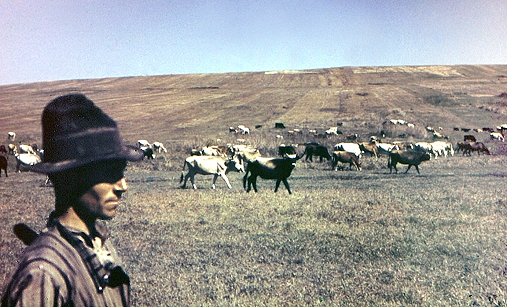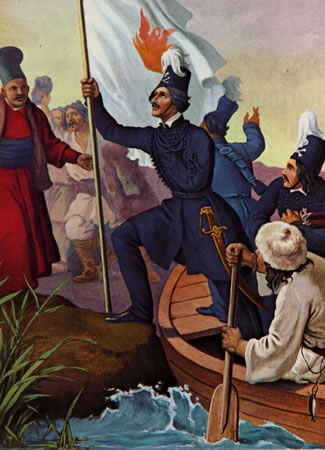|
Budjak (other)
Budjak, also known as Budzhak (Bulgarian, Russian and Ukrainian: Буджак, ro, Bugeac, Gagauz and Turkish: ''Bucak''), is a historical region that was part of Bessarabia from 1812 to 1940. Situated along the Black Sea, between the Danube and Dniester rivers, this multi-ethnic region covers an area of and is home to approximately 600,000 people. The majority of the region (former Izmail Oblast) is now located in Ukraine's Odesa Oblast, while the remaining part is found in the southern districts of Moldova. The region is bordered to the north by the rest of Moldova, to the west and south by Romania, and to the east by the Black Sea and the rest of Ukraine. Name and geography Historically, Budjak was the southeastern steppe region of Moldavia. Bordered by the northern Trajan's Wall at its north end, by the Danube river and Black Sea to its south, by Tigheci Hills (just east of the Prut River) to the west, and Dniester River to the east, it was known as ''historic Bessar ... [...More Info...] [...Related Items...] OR: [Wikipedia] [Google] [Baidu] |
Akkerman Fortress
Bilhorod-Dnistrovskyi ( uk, Бі́лгород-Дністро́вський, Bílhorod-Dnistróvskyy, ; ro, Cetatea Albă), historically known as Akkerman ( tr, Akkerman) or under different names, is a city, municipality and port situated on the right bank of the Dniester Liman (on the Dniester estuary leading to the Black Sea) in Odesa Oblast of southwestern Ukraine, in the historical region of Budjak. It also serves as the administrative center of Bilhorod-Dnistrovskyi Raion, one of seven districts of Odesa Oblast, and is the only locality which constitutes Bilhorod-Dnistrovskyi urban hromada, one of the hromadas of Ukraine. It is a location of a big freight seaport. Population: Nomenclature The city of Bilhorod-Dnistrovskyi is also referred to by alternative transliterations from Ukrainian as Bilhorod-Dnistrovsky or Bilhorod-Dnistrovskyy. ''Dnistrovsky'' was added to differentiate it from Bilhorod that was part of the Sloboda Ukraine and carried a similar name. ;Prev ... [...More Info...] [...Related Items...] OR: [Wikipedia] [Google] [Baidu] |
Ukraine
Ukraine ( uk, Україна, Ukraïna, ) is a country in Eastern Europe. It is the second-largest European country after Russia, which it borders to the east and northeast. Ukraine covers approximately . Prior to the ongoing Russian invasion, it was the eighth-most populous country in Europe, with a population of around 41 million people. It is also bordered by Belarus to the north; by Poland, Slovakia, and Hungary to the west; and by Romania and Moldova to the southwest; with a coastline along the Black Sea and the Sea of Azov to the south and southeast. Kyiv is the nation's capital and largest city. Ukraine's state language is Ukrainian; Russian is also widely spoken, especially in the east and south. During the Middle Ages, Ukraine was the site of early Slavic expansion and the area later became a key centre of East Slavic culture under the state of Kievan Rus', which emerged in the 9th century. The state eventually disintegrated into rival regional powers and ... [...More Info...] [...Related Items...] OR: [Wikipedia] [Google] [Baidu] |
Kiliia
Kiliia or Kilia ( uk, Кілія́, translit=Kiliia, ; ro, Chilia Nouă) is a town in Izmail Raion, Odesa Oblast of southwestern Ukraine. It hosts the administration of Kiliia urban hromada, one of the hromadas of Ukraine. Kiliia is located in the Danube Delta, in the Bessarabian historic district of Budjak; across the river lies the Romanian town of Chilia Veche (Old Kiliia). The Chilia branch of the Danube river, which separates Ukraine from Romania, is named after it. Population: History A town on the Romanian side of the Chilia branch of the Danube, now known as ''Chilia Veche'' ( uk, Cтapa Кілія, translit. ''Stara Kiliia'') or "Old Chilia", was founded by the Greek Byzantines – κελλία, ''kellia'' in Greek being the equivalent of "granaries", a name first recorded in 1241, in the works of the Persian chronicler Rashid-al-Din Hamadani. Kiliia is therefore sometimes referred to as ''Nova Kiliia'' meaning "New Kiliia". In the place that is now Kiliia, a lar ... [...More Info...] [...Related Items...] OR: [Wikipedia] [Google] [Baidu] |
Bender, Moldova
Bender (, Moldovan Cyrillic: Бендер) or Bendery (russian: Бендеры, , uk, Бендери), also known as Tighina ( ro, Tighina), is a city within the internationally recognized borders of Moldova under ''de facto'' control of the unrecognized Pridnestrovian Moldavian Republic (Transnistria) (PMR) since 1992. It is located on the western bank of the river Dniester in the Romanian historical region of Bessarabia. Together with its suburb Proteagailovca, the city forms a municipality, which is separate from Transnistria (as an administrative unit of Moldova) according to Moldovan law. Bender is located in the buffer zone established at the end of the 1992 War of Transnistria. While the Joint Control Commission has overriding powers in the city, Transnistria has ''de facto'' administrative control. The fortress of Tighina was one of the important historic fortresses of the Principality of Moldova until 1812. Name First mentioned in 1408 as ''Tyagyanyakyacha'' ... [...More Info...] [...Related Items...] OR: [Wikipedia] [Google] [Baidu] |
Bilhorod-Dnistrovskyi
Bilhorod-Dnistrovskyi ( uk, Бі́лгород-Дністро́вський, Bílhorod-Dnistróvskyy, ; ro, Cetatea Albă), historically known as Akkerman ( tr, Akkerman) or #Nomenclature, under different names, is a List of cities in Ukraine, city, List of hromadas of Ukraine, municipality and port situated on the right bank of the Dniester Liman (on the Dniester estuary leading to the Black Sea) in Odesa Oblast of southwestern Ukraine, in the historical region of Budjak. It also serves as the administrative center of Bilhorod-Dnistrovskyi Raion, one of seven districts of Odesa Oblast, and is the only locality which constitutes Bilhorod-Dnistrovskyi urban hromada, one of the hromadas of Ukraine. It is a location of a big Bilhorod-Dnistrovsky Seaport, freight seaport. Population: Nomenclature The city of Bilhorod-Dnistrovskyi is also referred to by alternative transliterations from Ukrainian as Bilhorod-Dnistrovsky or Bilhorod-Dnistrovskyy. ''Dnistrovsky'' was added to diff ... [...More Info...] [...Related Items...] OR: [Wikipedia] [Google] [Baidu] |
Nogais
The Nogais ( Nogai: Ногай, , Ногайлар, ) are a Turkic ethnic group who live in the North Caucasus region. Most are found in Northern Dagestan and Stavropol Krai, as well as in Karachay-Cherkessia and Astrakhan Oblast; some also live in Chechnya, Dobruja (Romania and Bulgaria), Turkey, Kazakhstan, Uzbekistan, Ukraine and a small Nogai diaspora is found in Jordan. They speak the Nogai language and are descendants of various Mongolic and Turkic tribes who formed the Nogai Horde. There are seven main groups of Nogais: the Ak Nogai, the Karagash, the Kuban-Nogai, the Kundraw-Nogai, the Qara-Nogai, the Utars and the Yurt-Nogai. Name For a long time it was believed that their namesake founder was Nogai Khan ( 'dog' in Mongolian), a grandson of Jochi. Nogai (d. 1299–1300) was the de facto ruler, kingmaker, and briefly self-proclaimed khan of the Golden Horde. Geographic distribution In the 1990s, 65,000 were still living in the Northern Caucasus, divided into A ... [...More Info...] [...Related Items...] OR: [Wikipedia] [Google] [Baidu] |
Prut
The Prut (also spelled in English as Pruth; , uk, Прут) is a long river in Eastern Europe. It is a left tributary of the Danube. In part of its course it forms Romania's border with Moldova and Ukraine. Characteristics The Prut originates on the eastern slope of Mount Hoverla, in the Carpathian Mountains in Ukraine (Ivano-Frankivsk Oblast). At first, the river flows to the north. Near Yaremche it turns to the northeast, and near Kolomyia to the south-east. Having reached the border between Moldova and Romania, it turns even more to the south-east, and then to the south. It eventually joins the Danube near Giurgiulești, east of Galați and west of Reni. Between 1918 and 1939, the river was partly in Poland and partly in Greater Romania (Romanian: ''România Mare''). Prior to World War I, it served as a border between Romania and the Russian Empire. After World War II, the river once again denoted a border, this time between Romania and the Soviet Union. Nowadays, for a l ... [...More Info...] [...Related Items...] OR: [Wikipedia] [Google] [Baidu] |
Tigheci Hills
Tigheci is a commune in Leova District, Moldova Moldova ( , ; ), officially the Republic of Moldova ( ro, Republica Moldova), is a landlocked country in Eastern Europe. It is bordered by Romania to the west and Ukraine to the north, east, and south. The unrecognised state of Transnist .... It is composed of two villages, Cuporani and Tigheci. References Communes of Leova District {{Leova-geo-stub ...[...More Info...] [...Related Items...] OR: [Wikipedia] [Google] [Baidu] |
Trajan's Wall
Trajan's Wall (''Valul lui Traian'' in Romanian) is the name used for several linear earthen fortifications ( valla) found across Eastern Europe, in Moldova, Romania, and Ukraine. Contrary to the name and popular belief, the ramparts were not built by Romans during Trajan's reign, but during other imperial periods. Furthermore, the association with the Roman Emperor may be a recent scholarly invention, only entering the imagination of the locals with the national awakening of the 19th century. Medieval Moldavian documents referred to the earthworks as ''Troian'', likely in reference to a mythological hero in the Romanian and Slavic folklore. The other major earthen fortification in Romania, Brazda lui Novac (''Novac's Furrow''), is also named after a mythological hero. Romania There are three valla in Romania, in south-central Dobruja, extending from the Danube to the Black Sea coast. While the relative chronology of the complex is widely accepted, the exact dating of each fo ... [...More Info...] [...Related Items...] OR: [Wikipedia] [Google] [Baidu] |
Moldavia
Moldavia ( ro, Moldova, or , literally "The Country of Moldavia"; in Romanian Cyrillic: or ; chu, Землѧ Молдавскаѧ; el, Ἡγεμονία τῆς Μολδαβίας) is a historical region and former principality in Central and Eastern Europe, corresponding to the territory between the Eastern Carpathians and the Dniester River. An initially independent and later autonomous state, it existed from the 14th century to 1859, when it united with Wallachia () as the basis of the modern Romanian state; at various times, Moldavia included the regions of Bessarabia (with the Budjak), all of Bukovina and Hertsa. The region of Pokuttya was also part of it for a period of time. The western half of Moldavia is now part of Romania, the eastern side belongs to the Republic of Moldova, and the northern and southeastern parts are territories of Ukraine. Name and etymology The original and short-lived reference to the region was ''Bogdania'', after Bogdan I, th ... [...More Info...] [...Related Items...] OR: [Wikipedia] [Google] [Baidu] |
Bugeac Steppe
The Bugeac Steppe, Budjak Steppe or Budzhak Steppe ( ro, Stepa Bugeacului; uk, Буджацький степ, Budzhats'kyy step) is a steppe located in the south of Ukraine and Moldova from the Dniester to Prut rivers reaching down to the Black Sea. The Bugeac Steppe has a total surface of 3,210 km2, of which 6.1% is forest. See also * Budjak Budjak or Budzhak ( Bulgarian and Ukrainian: Буджак; ro, Bugeac; Gagauz and Turkish: ''Bucak''), historically part of Bessarabia until 1812, is a historical region in Ukraine and Moldova. Lying along the Black Sea between the Danube ... References Grasslands of Moldova Grasslands of Ukraine {{Ukraine-geo-stub ... [...More Info...] [...Related Items...] OR: [Wikipedia] [Google] [Baidu] |



